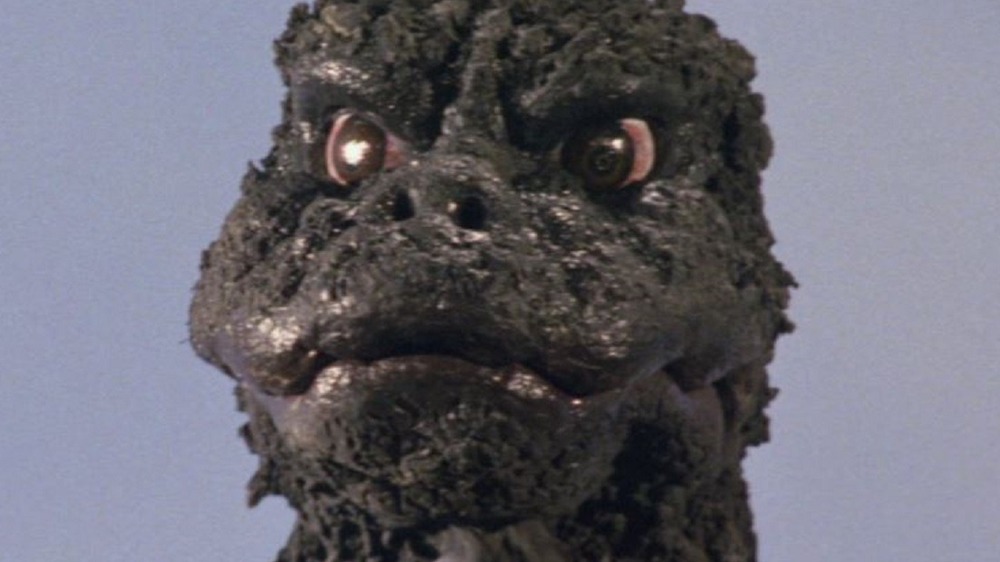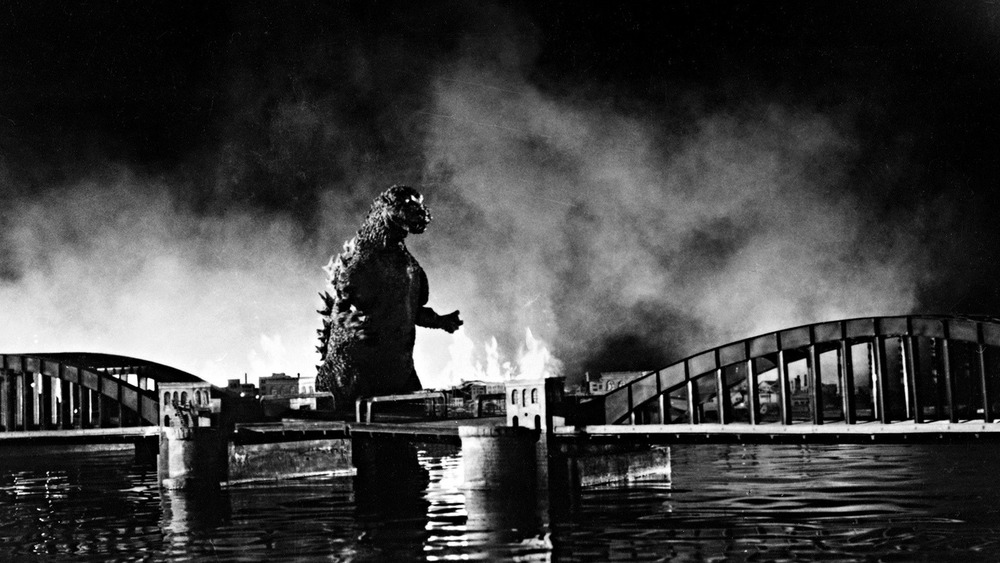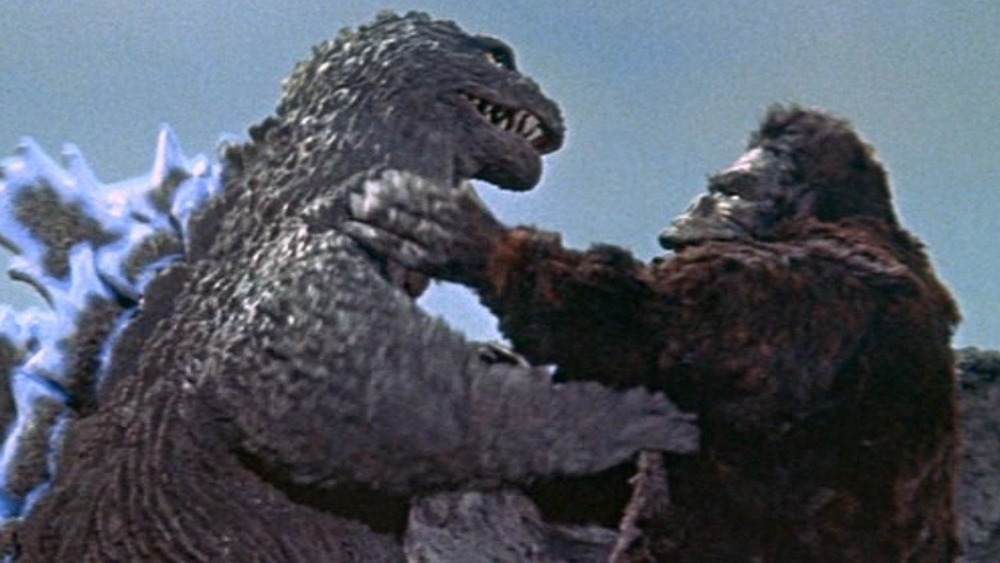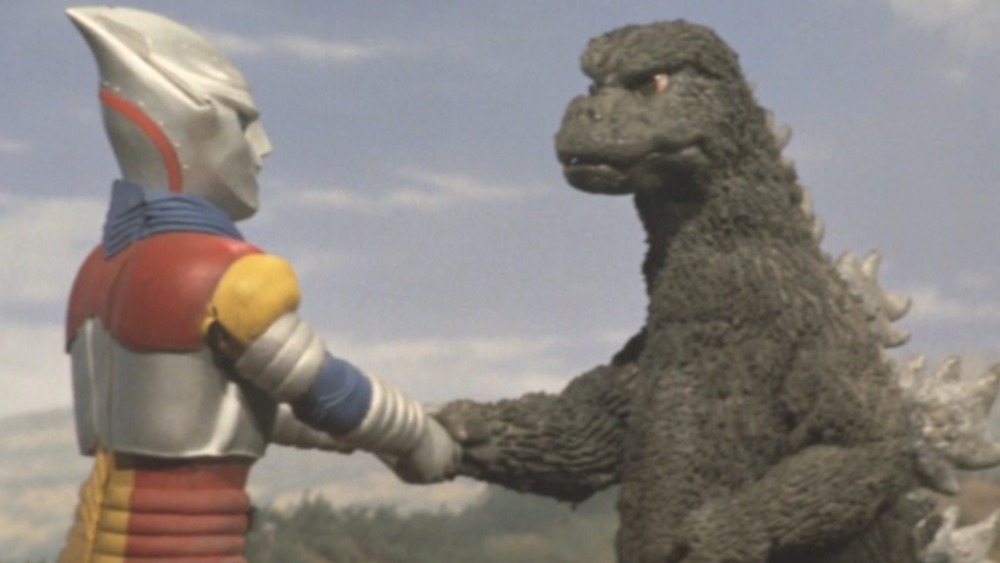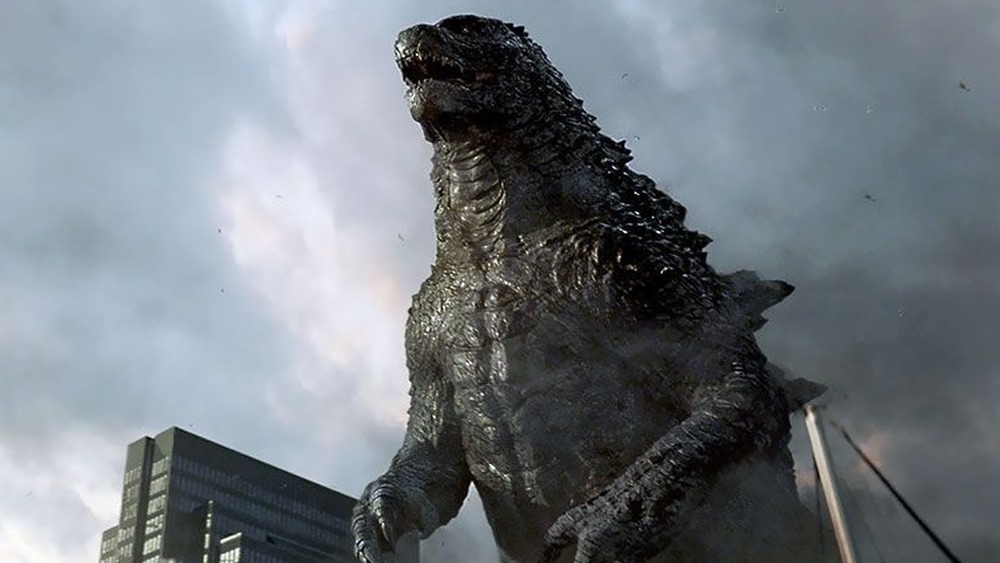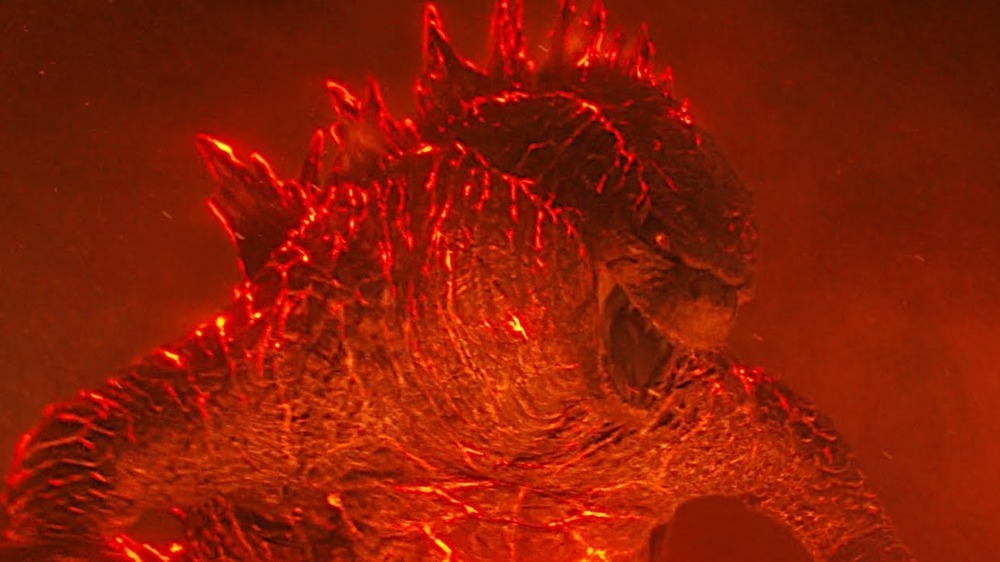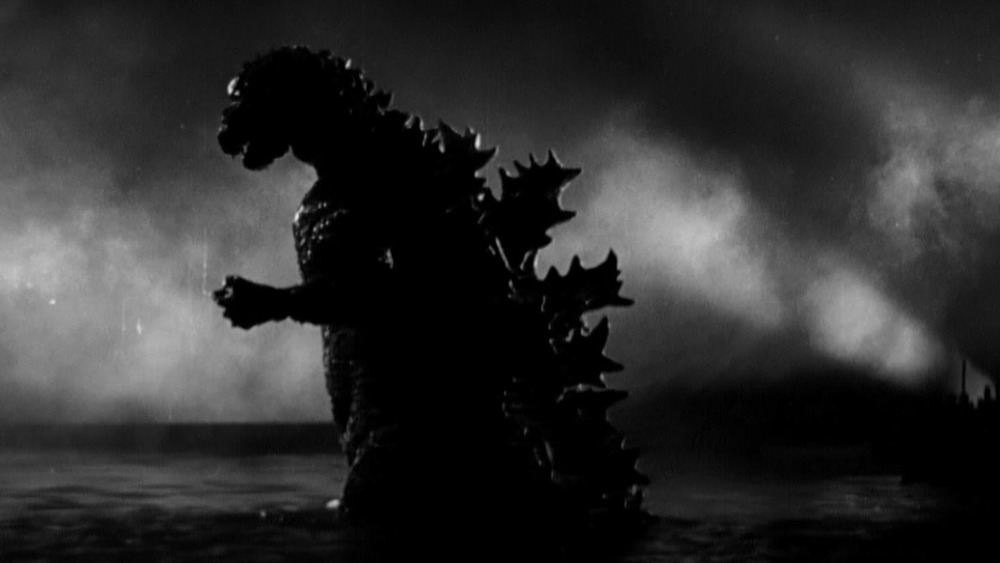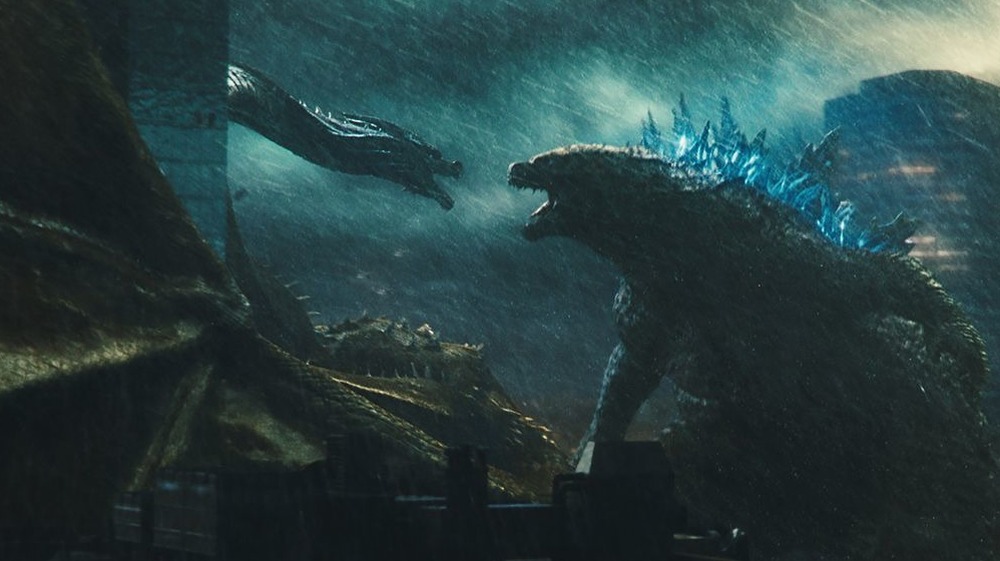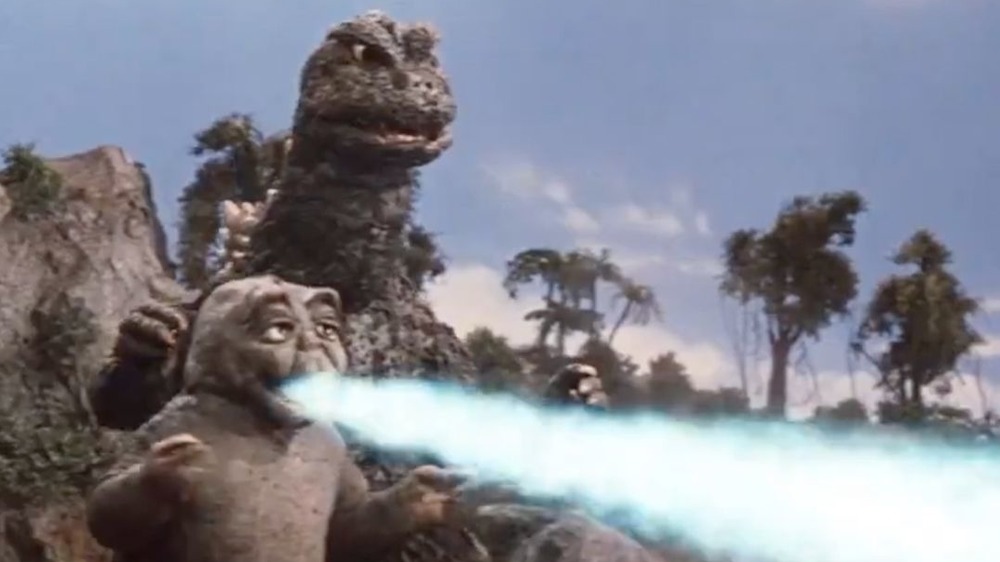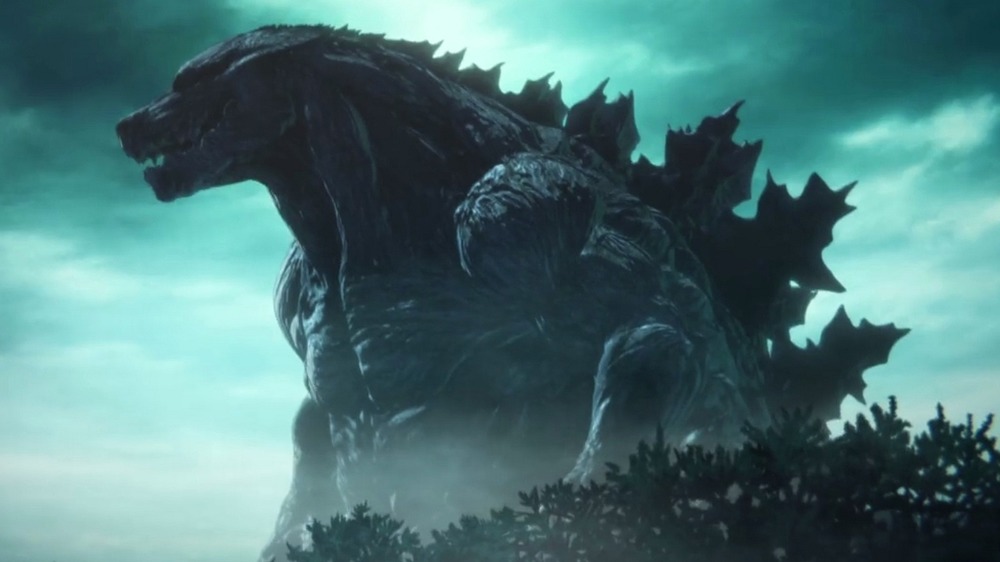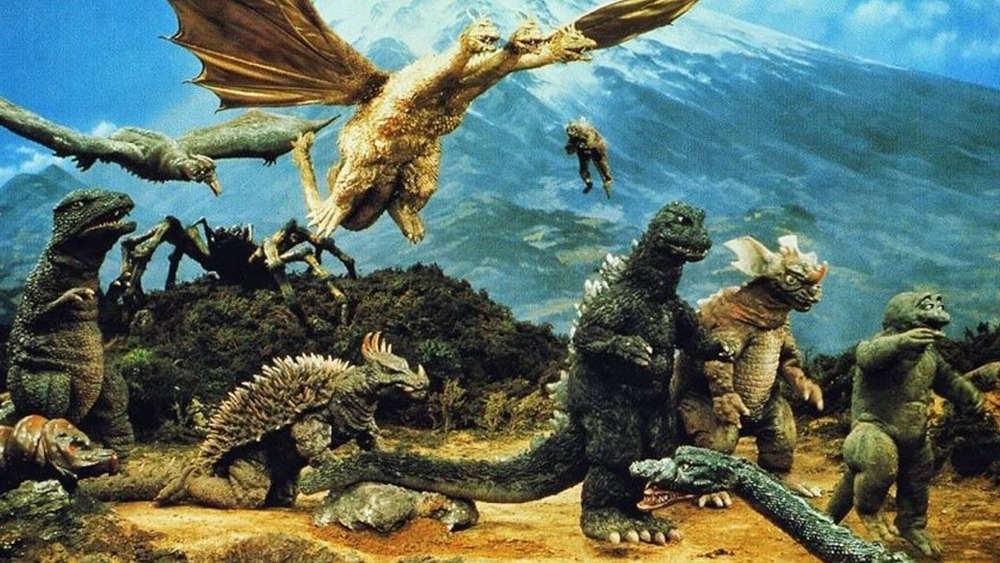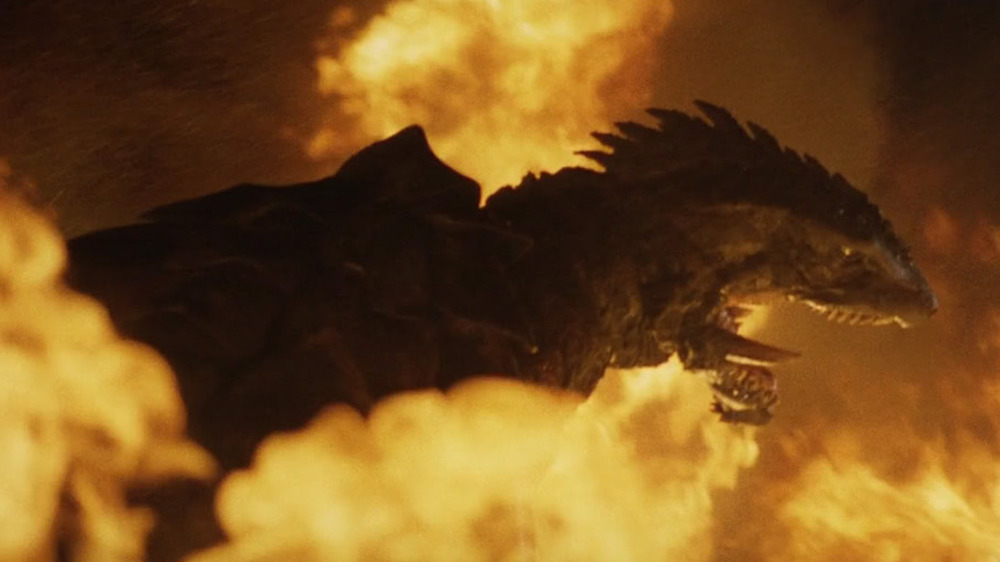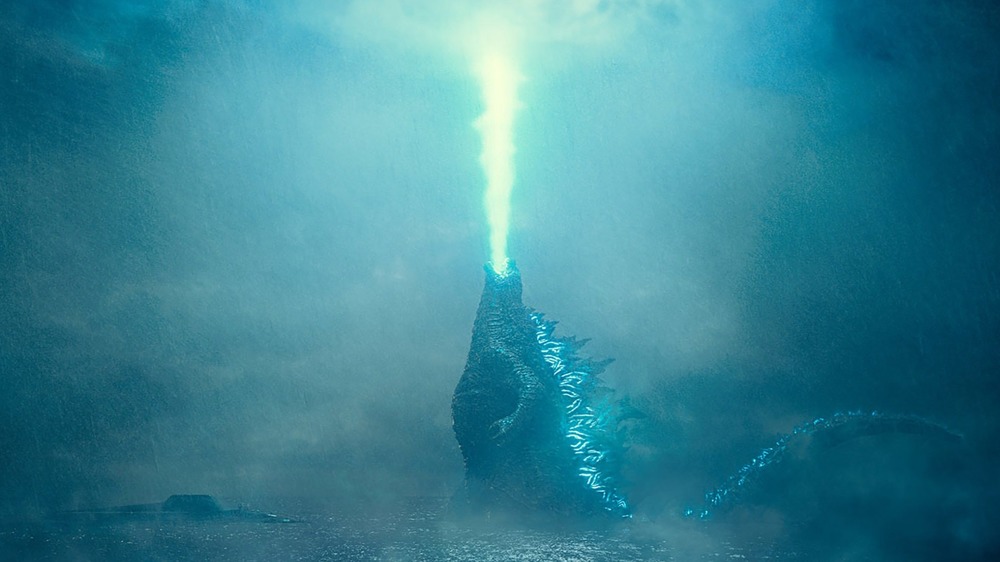Our Resident Expert Answers The World's Hardest Godzilla Questions
Godzilla first arrived upon cinema's shores back in 1954. Nearly 70 years later, you could argue Godzilla is Japan's most significant pop culture export. Before there was Pokémon, Dragon Ball Z, Hello Kitty, Studio Ghibli, and a bazillion other Japanese characters, genres, and consumer goods, there was Godzilla. As Japan's first mainstream, post-war cultural export, the big guy opened Japanese culture to the world.
Okay, so giving Godzilla partial credit for Sony or Toyota's success may be a bit much, but what can we say? We're G-fans. The point is, Godzilla's influence extends far beyond the Land of the Rising Sun, as the character is a global icon who popularized an entire genre, like Sherlock Holmes did with detective stories, Superman with superheroes, and Mickey Mouse with cute cartoon animals. Yet despite Godzilla's seven-decade career and over 35 movies, there's still so much about the character that most people don't know ... or rather, things they "know" that just aren't so.
Next time you're at a cocktail party discussing Godzilla (which happens all the time, right?), don't look like a fool. We brought our hardest questions to our resident Godzilla expert, so you can become one, too!
What is Godzilla?
In the original 1954 Godzilla, paleontologist Dr. Yamane (Takashi Shimura) speculates Godzilla is "a creature somewhere between the marine reptiles and the evolving terrestrial animals" that lived during the Cretaceous period. Godzilla was then removed from its natural habitat by nuclear testing. While we might question Dr. Yamane's credibility as a paleontologist (he said the Jurassic period was "2 million years ago," but it's more like 145-200 million years ago), his hypothesis is sound. So there you have it. Godzilla isn't a dinosaur but an intermediate species between aquatic and terrestrial reptiles.
Well, not so fast. This was only the Showa version (the 15 movies from 1954 to 1975) of the character. The Heisei Godzilla (1984 to 1995) is a dinosaur, from a made-up species called "Godzillasaurus" (zero points for originality there) that survived millions of years on a remote Pacific Island, up until atomic bombs mutated one into Godzilla. But to be honest, it gets more complicated than that.
Depending on the series or even the specific movie, Godzilla has been a mutated sea iguana (1998's Godzilla), an irradiated dinosaur possessed by dead soldiers (Godzilla, Mothra, King Ghidorah: Giant Monsters All-Out Attack), an unidentified sea creature deformed by nuclear waste (Shin Godzilla), a 252-million year old radioactive apex predator (the MonsterVerse), or even a 1,000-foot tall plant (Godzilla: Monster Planet). So yeah, it depends.
Did Godzilla defeat King Kong in the Japanese version?
It's the most enduring urban legend in the Godzilla mythos — Godzilla beat Kong in the Japanese cut of King Kong vs. Godzilla. It's also not true.
Yes, there are two versions of the film. There's 1963's 91-minute American version that spliced the original Japanese footage with new scenes featuring American actors. And then there's original, 97-minute, Japanese version from 1962, which was unavailable for years until the Criterion Collection released it as part of its "Godzilla: The Showa Films" box set. If you sit through the 188 minutes it takes to watch both versions, you'll know each has the same ending — Godzilla and Kong tumble into the ocean, but only Kong rises from the depths.
Now, you could argue that Kong was just retreating from the fight, but that's wishful thinking. After all, Godzilla's owner, Toho Studios, said Kong won the showdown. But why would Toho let their franchise star lose "the battle of the century?" Simple, Godzilla wasn't their franchise star ... yet. Yes, Godzilla was popular, but King Kong vs. Godzilla was only the character's third film, and it was coming after a seven-year hiatus. King Kong was, well, King Kong. The 1933 original was 30 years old at that point and an international phenomenon. It would be like if Superman fought Spider-Man in 1964. Besides being more powerful, Superman would win because he was more popular at the time. However, Toho had the last laugh, as King Kong vs. Godzilla elevated Godzilla to his now-legendary status.
Is Godzilla a hero or villain?
Godzilla is a hero to millions worldwide, but that doesn't mean he's a "hero." After all, fans love Darth Vader and Hannibal Lecter, too. This tells us that people are sick, and Godzilla's good/evil alignment is complicated. Godzilla was definitely the antagonist in 1954's Godzilla but in a Frankenstein Monster sense. He was a tragic creature mutated by mankind into a destructive force. Godzilla's death scene is even punctuated by a children's mournful choir. The takeaway? Humans are the true villains. Godzilla was the "bad guy" in the next three films before he became an anti-hero in 1964's Ghidorah, the Three-Headed Monster, and by the 1970s, he'd completed a total face turn.
In the 1984-1995 Heisei Series, Godzilla went back to being an anti-hero, fighting humans but defending Earth against even greater threats, which has been the character's sweet spot ever since. There are a few notable exceptions. In 2001's Godzilla, Mothra, King Ghidorah: Giant Monsters All-Out Attack, Godzilla broke bad, blasting a crowd of innocent bystanders and even going out of his way to tail-swipe a hospital! In 2016's Shin Godzilla and Netflix's Godzilla: Monster Planet trilogy, Godzilla is like the shark in Jaws, an ambivalent and almost mindless force of destruction. In the MonsterVerse films, Godzilla has been more "hero" than "anti-," as his true purpose is to "bring balance" (though he was called a "savior").
How did Godzilla get his name?
Had Godzilla been called "Dino-Mon" or "Radioactive Reptile," the first film would've been the last film. Instead, his name has given him serious staying power. After all, "God" connotes power and invincibility, while "-zilla", though originally meaningless, is now a synonym for "monstrous" (e.g. Hogzilla, Bridezilla, etc.). Want to convey size or strength? Just add "-zilla" to a word and hope Toho doesn't sue you. So where did "Godzilla" come from?
As even non-fans know, the Japanese call Godzilla "Gojira." Why? Well, when Godzilla's creators needed a name, fate intervened in the form of a heavy-set Toho employee. As Godzilla's director Ishiro Honda explained in Steve Ryfle's Japan's Favorite Mon-Star (via Vox), "There was a big ... fellow working in Toho's publicity department, and other employees would say, 'That guy's as big as a gorilla'. 'No he's almost as big as a kujira.' [Japanese for 'whale.'] Over time, the two mixed, and he was named 'Gojira.'"
Obviously, it's not Gorilla-Whale: King of the Monsters!, so how did Gojira become Godzilla? As Godzilla historian David Kalat explained in Criterion's DVD commentary, the beast's Japanese name is pronounced "Go-ji-ra". However, this became anglicized as English doesn't have the Japanese "ji" or "ra" sound, while Japanese doesn't have "-dzi" or "-l." So "Go-ji-ra" became "Go-dzi-la." Savvy movie marketers realized "Go-dzi-la" wouldn't fly, and it became "God-zill-a." So Gojira or Godzilla are both appropriate, though if you're not Japanese, saying "Gojira" just makes you a Snobzilla.
Just how powerful is Godzilla?
How powerful is Godzilla? Uh ... really, really powerful? Actually, Godzilla's power varies. Every version of Godzilla (except the 1998 American version) is virtually indestructible and can shoot a radioactive beam from its mouth. From there, Godzilla's power ranges from "powerful" to "overpowered" to "basically a god" to "basically a video game villain."
We won't rank the various versions, but there are standouts. Marvel Comics' 1970s version of Godzilla (part of Earth-616) went toe to toe with Thor and took on the combined might of the Avengers and S.H.I.E.L.D. The MonsterVerse Godzilla spent the 1950s getting blown up, and then he survived an Oxygen Destroyer, an atomic bomb, and being dropped from the atmosphere over the course of two days ... and still defeated a three-headed space dragon after going thermonuclear.
Godzilla Earth from Godzilla: Monster Planet conquered the world and drove humanity into exile for 20,000 years. But the most powerful/craziest Godzilla may be Shin Godzilla. The 2016 movie charted Godzilla's evolution from primitive organism to a race of Godzilla-human hybrids. As wild as that is, according to The Art of Shin Godzilla (reported by DangerVille), the original ending was set to go much further. Basically, the radioactive energy inside Godzilla would expand, making Godzilla too big for the planet and then the solar system. Eventually, Godzilla's nuclear core would begin to form stars and, finally, a separate universe. Shin Godzilla truly puts the "god" in Godzilla, as the monster is not only as powerful as an atomic bomb but the Big Bang itself!
Who created Godzilla?
Sherlock Holmes has Arthur Conan Doyle, Tarzan has Edgar Rice Burroughs, and Superman has Jerry Siegel and Joe Shuster. Most iconic characters have well-known creators, probably because many started in print. But Godzilla started in movies, an inherently collaborative medium, and he doesn't have just one creator.
For starters, longtime Toho producer Tomoyuki Tanaka was flying home after an Indonesian co-production fell through, when he looked out the window and imagined a giant monster rising from the sea. Of course, "giant monster rising from the sea" describes a lot of movies, and according to Today I Found Out, it was Tanaka's collaborators who helped bring Godzilla to life.
Tanaka originally wanted Godzilla to look like his namesake ("Gojira" is a portmanteau of "gorilla" and "kujira," Japanese for "whale"). When the gorilla-whale design was rejected, sculptor Teizo Toshimitsu and art director Akira Watanabe based their next design on a dinosaur, incorporating the ferocity of a Tyrannosaurus, the arms of an iguanodon, and the plates of a Stegosaurus, creating Godzilla's iconic look. In addition to his memorable theme, composer Akira Ifukube gave Godzilla his unmistakable roar by rubbing a resin-covered glove against the lowest string of a contrabass and playing it at various speeds (don't try this at home). SFX director Eiji Tsuburaya and suit-performer Haruo Nakajima gave Godzilla his personality, while director Ishiro Honda gave Godzilla his soul by infusing his wartime experience and anti-nuclear pacifism into the story.
How many fights has Godzilla won?
Godzilla's tempestuous personality rivals Conor McGregor's, so he's been in a lot of fights. As much as his spines, indestructibility, or radioactive breath, one of Godzilla's defining characteristic is that he never backs down from a fight. Unless it's the 1998 American version, who ran away from the military! Anyway, contrary to popular opinion, Godzilla doesn't always win. Blame the fact that Godzilla is oftentimes the antagonist, and you can't always let the bad guy win (even if moviegoers want him to).
So what's Godzilla's win-loss-draw record? Well, not counting the 1998 film, the animated properties, or the 1956 American edit of the original film, Godzilla's unofficial fight record is 44 wins, 11 losses, and four draws. Godzilla is currently 0-1 against King Kong, 3-2-1 against Mothra and her spawn, 1-0-1 against Rodan, 3-2-1 against MechaGodzilla, and an incredible 7-0 against his "top" foe, King Ghidorah. In fairness to the three-headed space dragon, Godzilla had help for most of those victories. Who's Godzilla's greatest foe based on the numbers? Humankind, as Godzilla has a 2-6 record against us. So congratulations, you're tougher than Godzilla.
Is Godzilla male or female?
Godzilla's gender is surprisingly complicated. The Japanese refer to Godzilla as "it," while Americans have defaulted to "he" ever since 1956's Godzilla: King of the Monsters. Is this just a cultural thing? Maybe, though there are some complicating factors. Godzilla has had a child a few times, with Minilla (aka Minya) in the Showa Era, Godzilla Junior in the Heisei Era, and Minilla again in the Millennium Era. Meanwhile, Shin Godzilla was able to produce a human-like species from its tail.
This suggests Godzilla is a female. However, the character's behavior with his kids has always been stereotypically fatherly, such as teaching his son how to shoot radioactive beams and fight bullies, which is why the Ad Council used Godzilla for its "It Takes a Man To Be A Dad" PSA (with voiceover by the paragon of manliness, Tom Selleck). The 1998 American Godzilla (which shouldn't count, but we're including for this discussion) was specifically called a male but was hermaphroditic and thus reproduced asexually.
So let's consult science to answer questions about a fictional character! Both male and female reptiles have internal sexual organs, and while true hermaphroditism is rare in reptiles, zoologists say the golden lancehead snake can have a third sex called intersex. Let's make it simple — how does Godzilla identify? As a badass monster.
How big is Godzilla?
The suffix "-zilla" is a synonym for "big," so every Godzilla has been gigantic. Even the 1998 American Godzilla, while distinctly un-Godzilla-like in every other way, was still huge. Size is arguably Godzilla's defining characteristic, as the only time Godzilla was small was when he was shrunk in the Marvel comic by S.H.I.E.L.D. However, Godzilla's size does fluctuate based on the filmmaker's vision.
According to Screen Rant, during the Showa Era, Godzilla was 164 feet tall, but he was upgraded for the Heisei Era to 262 feet and then 328 feet. Toho scaled Godzilla back down for most of the Millennium Era, with Godzilla's height ranging from 180 feet to 196 feet, before jumping back up to 328 feet. Meanwhile in America, the 1998 Godzilla was 230 feet, and the 2014 Godzilla was 354 feet. Not to be outdone, the Japanese made Shin Godzilla 388 feet, while Godzilla: King of the Monsters blew him up to around 390 feet. All big-screen movie versions are dwarfed by Hanna-Barbera's Godzilla (396 feet), while Marvel's Godzilla is the second-tallest at 603 feet. However, the biggest Godzilla by far is Godzilla Earth from Netflix's Godzilla: Monster Planet, who's around 1,000 feet tall!
What is a kaiju?
You've probably wondered, "What does 'kaiju' mean?" Once strictly the domain of monster movie nerds, the term "kaiju" has gone mainstream, and it's now on toys, video games, you name it. You may think "kaiju" is Japanese for "giant monsters," but it actually means "strange beasts." It refers to the film genre featuring oversized critters destroying cities, fighting other monsters, battling the military, etc. The term "kaiju eiga" (kaiju movie) specifically refers to Japanese monster flicks, and it's a sub-genre of "tokusatsu" (Japanese for "special effects"), which is oftentimes shortened to "toku" in the West.
"Toku" refers to all live-action, Japanese sci-fi/fantasy entertainment, from Godzilla to Power Rangers, and it's analogous to anime in defining an entire genre of Japanese entertainment. While "kaiju" technically references Japanese monster movies, it can honestly refer to any giant creature flick from around the world, like the United Kingdom (Gorgo), South Korea (Yongary), Denmark (Reptilicus), and the United States (The Beast from 20,000 Fathoms). The 2018 Dwayne Johnson-starrer Rampage was a kaiju movie, and "kaiju" were the evil alien monsters in Pacific Rim. While the original 1933 King Kong is retroactively considered the first kaiju film, the Japanese-influenced genre as we know it began with Godzilla in 1954.
Who would win – Godzilla or Gamera?
There's one character who fans wish Godzilla would go toe-to-toe with — Gamera. We can see the marquee ... Godzilla: King of the Monsters vs. Gamera: The Guardian of the Universe. As far as Godzilla rip-offs go, Gamera is the best. The secret to his success is Gamera's originality. Instead of a walking nuclear holocaust like Godzilla, Gamera is a flying, fire-breathing turtle who's a friend to children. It was a Hail Mary pass of imagination that connected, and Gamera has been in 12 films, including its own Showa (1965-1980) and Heisei (1995-2006) eras. But Godzilla and Gamera never threw hands for the same reason WWE's "Stone Cold" Steve Austin never fought WCW's Goldberg. The characters belong to different companies — Godzilla with Toho and Gamera with Daiei. Cue sad trombone.
Since we're unlikely to see them fight on film, fans can only speculate who would win. Gamera's height has ranged from 196 feet to 262 feet, so some Godzillas could literally step on him. Even putting them at the same height, we still side with Godzilla. Sure, Gamera's powers are impressive (he can summon the Earth's energy and shoot it from his chest) and his will to win is unmatched (he kept fighting after losing his hand and getting impaled), but Godzilla is on another level. It'd be like Conor McGregor fighting Brock Lesnar. Conor is feisty, but Brock's bigger and meaner. Big and mean wins. However, we can speculate all we want. Hopefully, one day the movies will give us a definitive answer.
Could Godzilla exist?
Even at his smallest (164 feet), Godzilla would be the largest animal to ever live. The real biggest animal ever, the blue whale, is 100 feet long and 200 tons, a pipsqueak next to Godzilla. However, it's so enormous that it has to be supported by the ocean to live. At his smallest, Godzilla's 60% bigger than a blue whale and walks upright on dry land. That's not possible according to physics and biology. As astrophysicist Neil deGrasse Tyson explained on Star Talk radio, "Godzilla would collapse under his own weight" because his limbs couldn't support his mass.
According to Business Insider, paleontologist Mike Habib agrees. He adds that Godzilla's heart wouldn't be large enough to pump blood to his brain, and "he'd have to have vessels you could drive a car through." The largest dinosaurs, the sauropods, got by because they walked on all fours and faced forward, so they didn't have to pump blood as far against gravity. Godzilla walks upright and is a lot bigger than even the biggest dinosaurs. Also, it'd take a full second for a nerve signal to travel through Godzilla's body (it takes yours 100 meters per second), so he'd be too slow to move. And he'd need to spend all day sun-bating to stay warm if he were cold-blooded, while if he were warm-blooded, his core temperatures would reach 300+ degrees, cooking him alive. Sorry, folks. It makes us sad too, but at least Godzilla will always exist in our imaginations.
